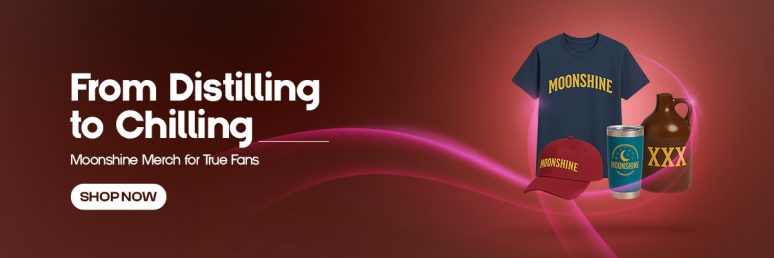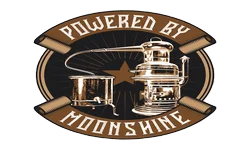Why Is Moonshine So Good? A Closer Look at Flavor and Tradition
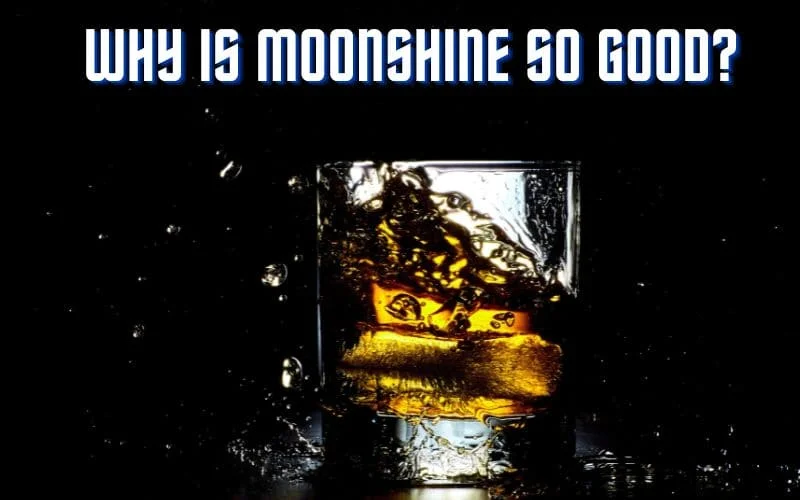
Article-at-a-Glance
- Moonshine’s distinctive flavor comes from its corn-based mash and unaged character, offering a raw, authentic taste experience unlike commercial spirits.
- Traditional copper still distillation imparts unique flavor notes that can’t be replicated in modern industrial equipment.
- The regional water sources used in moonshine production significantly influence its taste profile, with Appalachian mountain springs creating some of the most sought-after flavors.
- Fruit infusions like apple pie, blackberry, and peach have transformed moonshine from a harsh spirit to a versatile, flavorful liquor enjoyed in modern cocktail culture.
- With artisanal distilleries now legally producing moonshine, enthusiasts can safely explore this historically outlawed spirit without the dangers associated with unregulated production.
The mystique of moonshine has transcended its outlaw origins to become one of America’s most fascinating spirits. But what makes this unaged corn whiskey so captivating to modern palates? The answer lies in its remarkable simplicity and authenticity.
Moonshine’s Raw Appeal: What Makes It Special
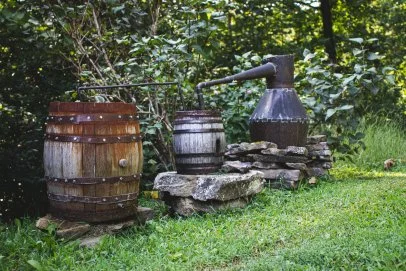
“What Is Moonshine? | Food Network” from www.foodnetwork.com and used with no modifications.
Moonshine represents the purest expression of American distilling tradition. Unlike most commercial spirits that undergo lengthy aging processes and flavor modifications, moonshine delivers an unapologetically honest drinking experience. This transparency of flavor allows you to taste the craftsmanship and ingredients in their most natural state, creating a connection to America’s distilling heritage that feels almost tangible with each sip.
The Unique Corn-Based Flavor Profile
Traditional moonshine starts with a mash bill dominated by corn, typically 80-90%, with smaller proportions of malted barley and sometimes wheat or rye. This corn-heavy recipe creates a distinctive sweetness that serves as the backbone of moonshine’s flavor profile. The corn imparts notes of fresh grain, sweet corn bread, and a subtle buttery quality that’s unmistakable. Unlike bourbon, which derives much of its character from oak aging, moonshine lets the natural grain flavors take center stage without interference.
“Good moonshine should taste like liquid cornbread with a kick. When made properly, it captures the essence of the grain in its purest form.” – Jimmy Russell, Master Distiller
Unaged Character: Tasting the Spirit’s True Essence
The absence of aging in traditional moonshine means you’re experiencing the distillate in its most fundamental form. Without barrel influence, there’s nowhere for flaws to hide, which is why quality moonshine requires exceptional distilling skill. When done right, unaged moonshine offers remarkable clarity with subtle complexity – clean grain notes followed by a gentle sweetness and a peppery finish that warms rather than burns.
This unaged character also means moonshine maintains a crystalline clarity that’s visually striking. While some commercial products may be slightly filtered to remove congeners, truly traditional moonshine has a slight opalescence that indicates the presence of essential oils from the grain – a sign of authentic, non-industrial production.
Higher Proof Means Bolder Experience
Authentic moonshine typically ranges from 100-150 proof (50-75% ABV), significantly higher than most commercial spirits. This high alcohol content serves a dual purpose. Historically, it maximized the value of each batch while making the product easier to transport discreetly. Today, this higher proof delivers a more intense flavor experience, as alcohol acts as a flavor carrier that amplifies the grain character.
The proper way to taste high-proof moonshine involves taking small sips and allowing the spirit to open up on your palate. Many enthusiasts add a few drops of spring water, which causes certain flavor compounds to bloom, revealing subtle notes that might otherwise be masked by the alcohol’s intensity.
The Secret Behind Moonshine’s Distinctive Taste

“Big Whiskey Wants a Taste …” from business.time.com and used with no modifications.
Beyond its basic ingredients, moonshine’s character is shaped by several key factors that skilled distillers carefully control. Understanding these elements helps explain why no two batches of traditionally-made moonshine taste exactly alike.
Traditional Ingredients That Shape Flavor
While corn forms the foundation, the supporting ingredients in moonshine significantly influence its final taste. Malted barley provides essential enzymes that convert starches to fermentable sugars while contributing subtle nutty, cereal notes. Some regional recipes incorporate wheat for smoothness or rye for a distinctive spiciness. Sugar is sometimes added to boost alcohol yield, though purists argue this dilutes the grain character. For those interested in the production process, you might wonder how much liquor 10 gallons of mash can make.
The yeast strains used in fermentation play an equally crucial role. Heritage distillers often maintain proprietary yeast cultures passed down through generations, with each strain producing different flavor compounds during fermentation. These yeast-derived congeners create fruity esters, spicy phenols, and other aromatic compounds that become concentrated during distillation.
The Copper Still Effect on Taste
Copper plays a pivotal role in moonshine’s distinctive flavor profile. Traditional copper stills don’t just heat the mash – they actively participate in the chemical reactions that shape the spirit’s character. As vapor rises through the copper, sulfur compounds bind to the metal, removing unwanted flavors that would otherwise make the moonshine harsh and unpleasant. This natural filtration creates a cleaner, sweeter spirit that showcases the grain’s natural sweetness rather than its impurities.
Regional Water Sources and Their Impact
The water used in moonshine production significantly influences its final taste. Limestone-filtered spring water, abundant in traditional moonshine regions like Kentucky and Tennessee, contributes a natural sweetness and essential minerals that support fermentation and enhance mouthfeel. Many heritage distillers refuse to use treated municipal water, insisting that authentic moonshine requires the same spring sources their ancestors used. This connection to the land creates terroir in moonshine similar to what we appreciate in fine wines.
The mineral content in different water sources affects everything from fermentation efficiency to the formation of congeners during distillation. Iron-rich water creates distinctly different flavor notes than calcium-rich sources, allowing regional moonshine styles to develop their own unique signatures even when using similar recipes.
Small-Batch Production Advantages
Traditional moonshine’s small-batch nature allows for meticulous attention to detail throughout the production process. Unlike industrial operations that prioritize consistency and efficiency, moonshine distillers can make real-time adjustments based on how each batch behaves. They monitor fermentation by sight and smell, making the critical “cuts” during distillation based on experience rather than automated systems. This hands-on approach preserves subtle flavor nuances that would be lost in larger production methods.
From Outlaw Spirit to Craft Sensation

“File:Question Mark.svg – Wikimedia Commons” from commons.wikimedia.org and used with no modifications.
Moonshine’s journey from prohibited contraband to celebrated craft spirit represents one of the most remarkable transformations in American drinking culture. This evolution has preserved traditional production methods while introducing the spirit to new audiences. For those curious about modern takes, exploring how to make infused moonshine can be an exciting venture into this storied beverage.
Prohibition’s Influence on Recipe Development
The Prohibition era (1920-1933) forced moonshine production underground but paradoxically contributed to its flavor development. Distillers needed to work quickly and discreetly, leading to innovations that maximized flavor while minimizing production time. Fruit infusions became popular during this period, not just to improve taste but to disguise the unmistakable aroma of a working still. Apple pie, blackberry, and peach variations emerged as ways to make harsh spirit more palatable while creating signature products that distinguished one producer from another.
These necessity-driven innovations became treasured family recipes that survive today in commercial craft distilleries. Many modern moonshine producers proudly advertise that their recipes date back to Prohibition, connecting consumers to this rebellious chapter in American history through authentic flavor profiles.
Family Secrets Passed Through Generations
The art of moonshine distillation has traditionally been preserved through oral history and apprenticeship rather than written documentation. Distilling families guarded their techniques carefully, creating lineages of knowledge that survived despite the legal risks. These family traditions encompassed everything from selecting the ideal water source to knowing exactly when to make the critical “cut” between the heads, hearts, and tails during distillation. The most closely guarded secrets often involved proprietary yeast strains, maintained through continuous use and carefully protected from contamination.
Today, many legitimate distilleries trace their moonshine recipes directly to these family traditions. Some proudly display photos of ancestors who once operated illegal stills, transforming what was once a necessity for survival into a marketing advantage that emphasizes authenticity and connection to American distilling heritage.
Modern Craft Distilleries Honoring Tradition
The craft distilling movement has embraced moonshine as a cornerstone product, with hundreds of distilleries now producing legal versions of this once-outlawed spirit. These modern producers balance respect for tradition with innovation, often using historical production methods while introducing new flavor profiles that appeal to contemporary palates. The best craft moonshine distillers maintain the spirit’s authentic character while ensuring consistency and safety that illegal production could never guarantee.
Popular Moonshine Flavor Infusions
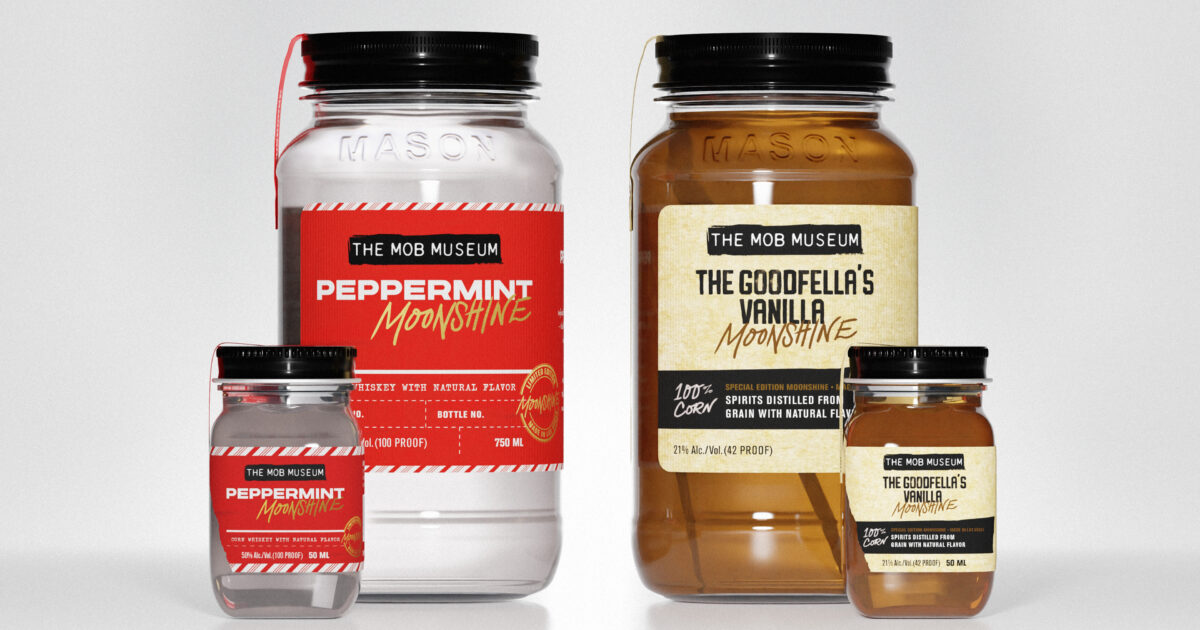
“Moonshine Flavors – Craft Spirits …” from craftspiritsmag.com and used with no modifications.
While purists appreciate traditional clear moonshine, flavored variations have become tremendously popular in recent years. These infusions build on historical traditions while offering accessible entry points for new moonshine enthusiasts.
1. Apple Pie Moonshine
Perhaps the most beloved moonshine variation, apple pie moonshine transforms the raw spirit into a dessert-like experience that captures the essence of America’s favorite pie. Traditional recipes combine fresh apple cider, cinnamon sticks, cloves, and vanilla with high-proof moonshine, then allow the mixture to mellow for several weeks. The result balances warming baking spices with bright apple flavor and underlying grain sweetness from the base spirit. Modern commercial versions often add caramel coloring and sweeteners, though traditionalists prefer natural ingredients and the authentic pale golden hue that comes from real apple infusion.
2. Blackberry Moonshine
Blackberry moonshine stands as a testament to Southern ingenuity and the abundant wild berries that grow throughout moonshine country. Traditional distillers would harvest wild blackberries in late summer, crush them gently, and allow them to macerate in fresh moonshine for weeks or months. The spirit extracts both color and flavor, resulting in a deep purple liquid with remarkable complexity – tart berry notes balanced against the corn sweetness of the base spirit.
Modern variations often accelerate this process through controlled extraction techniques, but the best examples still rely on real fruit rather than artificial flavors. A well-made blackberry moonshine delivers the perfect balance of sweetness and acidity, with the natural tannins from the berries providing structure that complements the spirit’s inherent warmth.
3. Peach Moonshine
In Georgia and other Southern states, peach-infused moonshine represents the perfect marriage of regional agriculture and distilling tradition. Fresh, ripe peaches impart their delicate floral sweetness to the spirit, creating a smooth, approachable variation that masks much of moonshine’s characteristic heat. The natural sugars in peaches ferment slightly during infusion, adding complexity while mellowing the high proof of traditional ‘shine. For those interested in creating their own infused spirits, here’s a guide on how to make infused moonshine.
The best peach moonshine captures the essence of a perfectly ripe peach without excessive sweetness. Commercial versions vary dramatically in quality, with artisanal producers typically using real fruit while mass-market brands often rely on artificial flavors and added sweeteners. For the authentic experience, look for versions with visible peach sediment or natural cloudiness.
4. Cherry Moonshine
Cherry moonshine combines the bold, slightly medicinal flavor of cherries with the grain-forward character of traditional moonshine. This variation gained popularity during Prohibition when distillers discovered that sour cherries could mask both the aroma of production and the harsh edges of hastily-made spirit. Today’s versions typically use a combination of sweet and sour cherries to create a balanced profile reminiscent of cherry pie filling but with a serious alcoholic kick.
Regional variations abound, with some Appalachian recipes incorporating wild black cherries for a more tannic, complex flavor, while Midwestern versions often feature the brighter notes of tart Montmorency cherries. The best examples allow the cherries to infuse slowly, extracting both color and flavor compounds that integrate seamlessly with the base spirit.
5. Cinnamon Moonshine
Cinnamon moonshine delivers an intense, warming experience that amplifies moonshine’s natural heat with spicy cinnamon. Traditional recipes use whole cinnamon sticks rather than extracts, allowing the complex aromatics to slowly infuse into the spirit. The result combines the sweet corn notes of the moonshine with the spicy, slightly sweet character of quality cinnamon.
This variation has gained tremendous commercial popularity in recent years, with brands like Ole Smoky and Midnight Moon offering their interpretations. The most balanced versions avoid excessive sweetness, allowing the natural grain character to complement rather than be overwhelmed by the cinnamon. When properly made, cinnamon moonshine offers warming comfort in cold weather while maintaining the distinctive character that makes moonshine unique.
Regional Moonshine Variations Across America

“Clear Whiskey Taste Off: Tennessee …” from rickhouseramblings.com and used with no modifications.
Like any traditional spirit, moonshine has developed distinct regional characteristics influenced by local ingredients, climate, and cultural preferences. These geographical variations offer fascinating insights into America’s diverse distilling traditions.
Appalachian Mountain Styles
The Appalachian region – spanning from Pennsylvania through the Carolinas and into Georgia – represents moonshine’s spiritual homeland. Here, distillers traditionally use high corn mash bills, often 80-90% corn, creating a distinctively sweet, full-bodied spirit. The abundant limestone-filtered spring water found throughout the mountain range contributes mineral notes and supports efficient fermentation. Appalachian ‘shiners typically employ simple pot stills without rectification columns, preserving more of the grain’s natural flavor compounds.
Family recipes in this region often include small amounts of rye or malted barley to complement the corn base. The resulting spirits tend to have noticeable sweetness upfront with a peppery finish that lingers pleasantly. Many Appalachian distillers maintain that the region’s dramatic seasonal temperature changes contribute to more efficient fermentation and distinctive flavor development.
Southern State Specialties
While sharing many characteristics with Appalachian styles, Southern moonshine from states like Georgia, Alabama, and Mississippi often reflects agricultural differences and cultural preferences. Sugar cane grows abundantly in parts of the deep South, leading to traditions of “sugar shine” that incorporate cane juice or molasses into the mash. These additions create lighter-bodied spirits with subtle tropical notes not found in purely grain-based recipes. If you’re interested in exploring different methods, learn how to make infused moonshine for a unique twist.
Southern moonshine traditions also heavily emphasize fruit infusions, particularly peach, plum, and various berries that thrive in the warm climate. The longer growing season allows distillers to work with fresh fruit throughout much of the year, creating seasonal specialties that showcase regional agriculture. Georgia’s peach moonshine and Mississippi’s muscadine grape variations exemplify these distinctive regional expressions.
How Moonshine Is Made Today
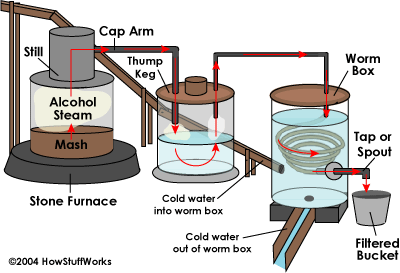
“How Moonshine Works – Walton’s Distillery” from www.waltonsdistillery.com and used with no modifications.
Modern moonshine production balances traditional methods with contemporary safety standards and consistency requirements. Understanding this process helps appreciate the craftsmanship behind quality moonshine.
The Mashing Process
The journey begins with creating a mash – a mixture of crushed grains, water, and sometimes malted barley to provide enzymes that convert starches to fermentable sugars. Traditional recipes typically use a ratio of 80-90% corn with smaller amounts of malted barley and sometimes wheat or rye. The grains are mixed with hot water (usually around 150°F) and held at specific temperature ranges to allow enzymatic conversion of starches to sugars.
Modern distillers carefully monitor pH and temperature throughout this process, though traditional moonshiners relied on experience and touch to determine when the mash was ready. Some heritage recipes include unusual ingredients like dried fruit or small amounts of previous batch “backset” to increase acidity and contribute flavor complexity. After conversion is complete, the mash is cooled to fermentation temperature, typically 70-85°F.
Fermentation Techniques
Fermentation transforms the sugars in the mash into alcohol through yeast activity. Traditional moonshiners often maintained proprietary yeast strains, sometimes captured from the wild or preserved from previous successful batches. Modern craft distillers may use specialized distillers’ yeast or even repurposed beer and wine yeasts to create distinctive flavor profiles.
Fermentation typically takes 3-7 days, depending on temperature, yeast strain, and recipe specifics. During this period, the mash bubbles actively as yeast converts sugars to alcohol and carbon dioxide. The finished “wash” typically reaches 8-12% ABV before distillation. Temperature control during fermentation significantly impacts flavor development – cooler fermentations produce more fruity esters while warmer conditions create spicier, more robust profiles.
Distillation Methods That Preserve Flavor
Distillation concentrates the alcohol and flavors from the fermented wash. Traditional moonshine is produced in simple pot stills, often handmade from copper. The wash is heated until alcohol (which boils at a lower temperature than water) vaporizes, rises through the still, and condenses back to liquid in higher concentration.
Master distillers carefully separate the distillate into “cuts” – the heads (first portion) contain volatile compounds that can be harsh or dangerous and are discarded. The hearts (middle portion) represent the clean, flavorful spirit that becomes moonshine. The tails (final portion) contain fusel oils and other heavy compounds that affect quality and are typically set aside. This careful separation, done primarily by smell and taste in traditional production, ensures both safety and optimal flavor.
Legal Moonshine vs. Traditional ‘Shine

“Legal Moonshine …” from chuckcowdery.blogspot.com and used with no modifications.
The legalization of moonshine has transformed what was once an underground practice into a legitimate industry. This transition has preserved many traditional aspects while introducing important safety standards and consistency.
Safety Standards in Commercial Production
Legal moonshine distilleries must adhere to strict regulations that ensure product safety. Commercial stills are properly constructed with food-grade materials, eliminating the risk of lead soldering or other dangerous metals leaching into the spirit. Temperature controls and modern distillation equipment allow precise separation of methanol and other harmful compounds that can be present in poorly-made illicit spirits.
Quality testing for commercial moonshine includes laboratory analysis for methanol content, proof verification, and microbial testing. These safety measures eliminate the dangers historically associated with underground production while maintaining the spirit’s authentic character. Consumers can now enjoy the unique flavor of moonshine without the health risks that once accompanied this outlaw spirit.
Taste Differences Between Legal and Illicit Spirits
While legal moonshine preserves traditional recipes, some connoisseurs argue that subtle differences exist between commercial products and traditional illicit spirits. Legal distilleries typically use consistent grain sources rather than whatever local crops were available, resulting in more predictable flavor profiles. Commercial filtration and modern equipment produce cleaner spirits with fewer congeners – the compounds that contribute both flavor complexity and potential harshness. Curious about the potency of moonshine? Discover if moonshine is the most powerful drink and learn more about its unique characteristics.
The best craft distilleries balance modern safety standards with traditional production methods, often employing copper pot stills and avoiding excessive filtration that might strip away characteristic flavors. Some even maintain regional water sources and heritage grain varieties to preserve authentic terroir. The result is a spirit that captures moonshine’s distinctive character without the inconsistency and danger of underground production.
“Today’s legal moonshine bridges history and innovation. We use my grandfather’s recipe but with safety standards he could only have dreamed of.” – Chuck Miller, Midnight Moon Distillery
Moonshine’s Place in American Culture

“Flag of the United States – Wikipedia” from en.wikipedia.org and used with no modifications.
Few spirits are as deeply embedded in American cultural identity as moonshine. From Appalachian folk songs to Hollywood films, this rebellious spirit represents independence, resourcefulness, and resistance to authority.
Songs and Stories Celebrating White Lightning
Moonshine has inspired countless country and folk songs, with artists from Hank Williams to Dolly Parton celebrating the spirit’s outlaw heritage. Classic tracks like “White Lightning” by George Jones and “Copper Kettle” by Joan Baez romanticize moonshine production as an act of independence and cultural preservation. These musical tributes have helped transform moonshine from a simple alcoholic beverage into a symbol of American resourcefulness and resistance to government overreach.
Literature and film have similarly mythologized moonshine culture. From Elmore Leonard’s “Raylan” to movies like “Lawless” and “Thunder Road,” moonshine runners are portrayed as folk heroes fighting against unfair taxation and government interference. This cultural positioning has elevated moonshine beyond its physical properties to represent core American values of self-sufficiency and personal liberty.
Community Bonds Formed Through Shared Traditions
Historically, moonshine production created tight-knit communities bound by shared secrets and mutual protection. Families involved in distilling developed complex networks of lookouts, distributors, and customers who relied on one another’s discretion. These connections formed the basis of community trust that extended beyond moonshine into other aspects of rural life.
Today, legal moonshine production continues to strengthen community bonds through different means. Craft distilleries often become tourist destinations that showcase local agricultural products and cultural heritage. Festivals celebrating moonshine traditions bring together enthusiasts from diverse backgrounds, preserving historical knowledge while creating new appreciation for this distinctive American spirit.
Try These Moonshine Cocktails
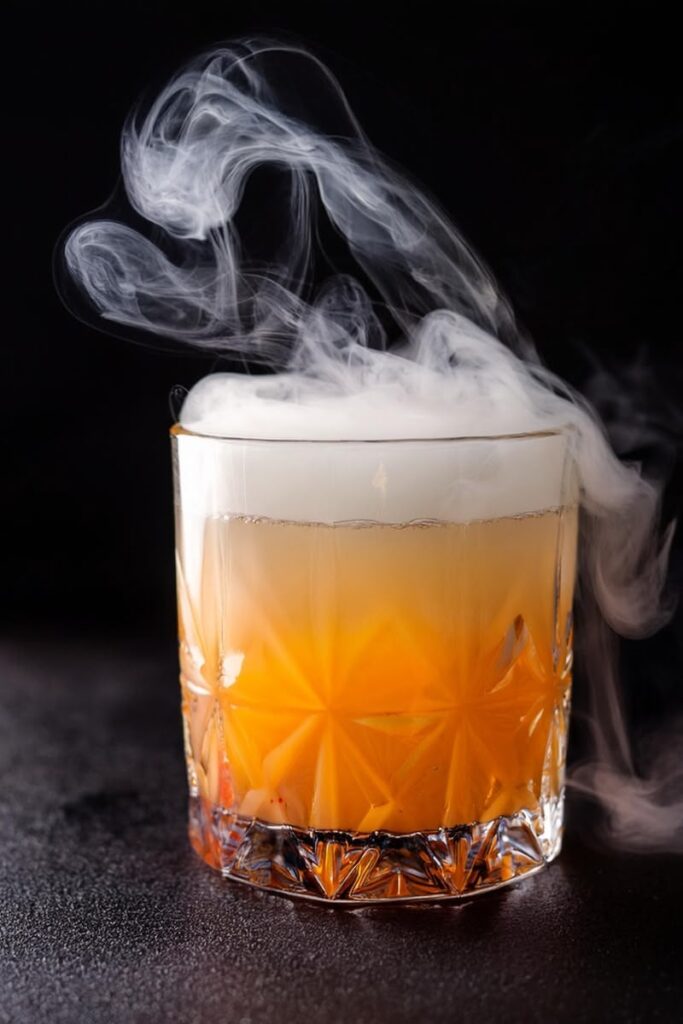
“Good Moonshine Cocktails for Halloween …” from midnightmoonshine.com and used with no modifications.
While traditionalists prefer their moonshine straight, modern mixologists have embraced this versatile spirit in creative cocktails that highlight its distinctive grain character and high proof. These recipes transform moonshine from a sipping curiosity into a flexible cocktail base.
1. Mountain Mule
This Appalachian twist on the Moscow Mule pairs unflavored moonshine with spicy ginger beer, fresh lime juice, and a dash of bitters. The moonshine’s corn sweetness complements the ginger’s heat while the lime provides balancing acidity. Serve in a copper mug with plenty of ice and garnish with a lime wheel and sprig of mint for an aromatic finish that enhances the drinking experience.
2. Firefly Lemonade
Perfect for summer gatherings, Firefly Lemonade combines apple pie moonshine with fresh lemonade and a splash of soda water. The moonshine’s cinnamon and apple notes complement the bright citrus, while the carbonation lightens the drink’s body. For an extra dimension, muddle fresh berries in the bottom of the glass before adding the other ingredients.
This refreshing cocktail demonstrates how flavored moonshine can transform simple ingredients into sophisticated drinks. The high proof ensures the spirit’s character shines through even with significant dilution, making it ideal for batch preparation at outdoor events.
The visual appeal of this cocktail adds to its charm – the pale amber moonshine creates a sunset effect when layered with ruby-red berries and bright yellow lemonade. Garnish with a cinnamon stick that doubles as a stirrer to enhance the aromatics each time the drink is agitated.
- 2 oz apple pie moonshine
- 4 oz fresh lemonade
- 1 oz soda water
- Fresh berries (blackberries, raspberries, or strawberries)
- Cinnamon stick for garnish
3. Midnight Runner
This sophisticated cocktail showcases moonshine’s versatility in more complex drink preparations. Combine clear moonshine with fresh blackberry syrup, lemon juice, and a float of dry red wine for a layered cocktail with remarkable depth. The moonshine provides strength and underlying sweetness, while the wine adds tannic structure and visual appeal as it floats on top of the mixture.
Finding Quality Moonshine Worth Your Money

“Appalachian Distillery in Ripley, WV” from appalachian-moonshine.com and used with no modifications.
With dozens of commercial moonshines now available, selecting quality products requires understanding what separates exceptional examples from mediocre imitations. The best moonshine balances authenticity with refinement, offering a genuine taste of tradition with consistent quality. For those interested in learning more about the process, understanding how to make infused moonshine can provide insight into the craftsmanship involved.
Truly exceptional moonshine starts with premium ingredients – non-GMO corn, small grains from local farms, and pure water sources. Production methods matter equally, with copper pot distillation and minimal filtration preserving the spirit’s essential character. Look for distilleries that emphasize their connection to moonshine traditions while employing modern safety standards.
Flavor profiles vary widely across brands, from raw, intense corn spirits to smoother, more refined expressions. Neither style is inherently superior – your preference depends on whether you’re seeking an authentic historical experience or a more approachable introduction to the category. Many distilleries offer sample sizes that allow exploration without significant investment. For those interested in the aging process, you might want to explore the differences between aging moonshine in glass vs oak.
| Moonshine Style | Flavor Profile | Best Used For |
|---|---|---|
| Traditional Clear | Bold corn sweetness, peppery finish | Sipping, strong cocktails |
| Apple Pie | Baking spices, fresh apple, vanilla | Dessert drinks, autumn cocktails |
| Blackberry | Jammy fruit, subtle tannins | Summer punches, with lemonade |
| Peach | Floral sweetness, stone fruit | Fruit cocktails, with iced tea |
| Cinnamon | Intense spice, warming heat | Winter drinks, cider spike |
Price points for quality moonshine typically range from $25-50 for standard 750ml bottles, with premium or special editions commanding higher prices. While higher cost doesn’t guarantee quality, suspiciously cheap moonshine often uses inferior ingredients or artificial flavors that compromise authenticity.
What to Look for on Labels
Navigating moonshine labels requires understanding both legal requirements and marketing terminology. The term “moonshine” itself has no legal definition, allowing considerable flexibility in what producers can call by this name. Instead, focus on specific production details that indicate quality and authenticity.
Look for clear statements about distillation methods (pot still distilled is generally preferred for authentic character), grain sources (100% corn or high-corn mash bills for traditional flavor), and proof (higher proofs typically indicate less dilution). Many quality producers proudly list their water sources, particularly if using renowned springs or limestone-filtered water. For flavored variations, verify that real ingredients rather than artificial flavors are used – “made with real peaches” versus simply “peach flavored” makes a significant difference in quality. For more insights, check out this article on moonshine history and uses.
Award-Winning Brands to Try
Several distilleries have earned recognition for exceptional moonshine that balances tradition with consistent quality. Ole Smoky Tennessee Moonshine pioneered the legal moonshine movement with their Gatlinburg distillery, offering traditional clear ‘shine alongside popular flavored variations. Sugarlands Distilling Company produces award-winning spirits using authentic Appalachian recipes, while Midnight Moon draws on the legendary Junior Johnson’s family traditions. Smaller regional producers like Climax Moonshine (Tim Smith’s legal version of his previously illicit spirit) and Call Family Distillers offer authentic mountain heritage in every bottle. For those interested in the science behind moonshine, understanding what temperature kills distillers yeast can be crucial for producing quality spirits.
Price Points and What They Mean
Moonshine pricing reflects both production methods and brand positioning. Entry-level options ($15-25) typically use industrial production methods and may contain neutral grain spirit rather than authentic corn distillate. Mid-range products ($25-40) represent the sweet spot for quality and value, with most authentic craft distillers positioning their flagship products in this range.
Premium moonshines ($40+) typically feature either special production methods (heritage grain varieties, unique water sources) or limited availability. While the spirit’s unaged nature means extremely expensive moonshine rarely offers proportional quality increases, these premium expressions often showcase interesting experimental techniques or exceptional raw ingredients that justify their higher prices for enthusiasts.
“The best value in moonshine comes from established craft distilleries that have scaled enough to control costs while maintaining traditional production methods. Look for distilleries that own their stills rather than contract producing.” – Colin Blake, Moonshine Historian
The Spirit of American Independence
“Embracing the Spirit of Independence on …” from www.linkedin.com and used with no modifications.
More than just a beverage, moonshine embodies the independent spirit that has defined American culture since its founding. Born from necessity during times when legal alcohol was either prohibited or prohibitively taxed, moonshine represents resistance to authority and self-reliance in the face of government restriction. This heritage connects modern drinkers to generations of Americans who valued freedom and resourcefulness above rigid adherence to regulations they considered unjust. For a deeper understanding, explore the history and uses of moonshine.
Today’s legal moonshine industry has transformed this rebellious heritage into a celebration of American craftsmanship and agricultural bounty. The corn that forms moonshine’s backbone represents America’s most iconic crop, while the regional variations showcase the country’s diverse terroir and cultural influences. By preserving traditional production methods while embracing modern safety standards, contemporary moonshine distillers honor their outlaw predecessors while creating spirits that can be safely enjoyed by new generations. For those curious about the nuances of moonshine production, understanding aging moonshine in glass vs. oak can provide deeper insights into how these spirits are crafted.
- Celebrates American agricultural heritage and corn farming traditions
- Preserves historical production methods that might otherwise be lost
- Supports rural economies through tourism and agricultural purchases
- Connects consumers to authentic American cultural traditions
As you explore the world of moonshine, remember that each glass represents not just a flavor experience but a connection to American history. Whether enjoyed straight, in cocktails, or as a cooking ingredient, moonshine offers a taste of independence and tradition that few other spirits can match.
Frequently Asked Questions
The mysterious nature of moonshine leads to many common questions about its production, legality, and proper enjoyment. These answers provide clarity on the most frequently asked topics.
Is moonshine legal to buy and make now?
Commercially produced moonshine sold by licensed distilleries is completely legal to purchase in the United States, though some states have restrictions on direct shipping. However, home distillation remains illegal without proper federal permits, regardless of state laws. While home beer and wine production is legal for personal consumption, distilling spirits without permits violates federal law and carries significant penalties. The legal distinction focuses on the distillation process itself, not the ingredients or recipe used.
What proof is typical moonshine?
Traditional moonshine typically ranges from 100-150 proof (50-75% alcohol by volume), significantly higher than most commercial spirits. Legal moonshine products must comply with federal regulations that cap spirits at 190 proof (95% ABV), though most commercial versions are sold at 80-100 proof to appeal to mainstream consumers. Higher proof versions more accurately represent historical moonshine but require careful consumption due to their intensity.
The proof of moonshine was traditionally tested through crude but effective methods. The “shake test” involved shaking a jar of moonshine and observing the bubbles – proper proof moonshine would produce bubbles that dissipated at a specific rate. More dangerously, some producers would pour moonshine over gunpowder and attempt to light it – if the powder ignited, the moonshine was considered “proof” (this is actually the historical origin of the term “proof” for alcohol strength).
Modern commercial moonshine is precisely measured using scientific equipment to ensure consistent proof in every bottle, eliminating the guesswork that characterized traditional production. This consistency allows consumers to reliably judge a product’s strength before consumption.
Can moonshine go bad if stored improperly?
Unlike aged spirits that remain stable indefinitely, moonshine can deteriorate if improperly stored. The high alcohol content prevents microbial spoilage, but flavor compounds can degrade with exposure to heat, light, and oxygen. Fruit-infused moonshines are particularly vulnerable to quality loss, as the natural fruit compounds oxidize over time. For optimal preservation, store moonshine in tightly sealed glass containers away from direct sunlight and temperature fluctuations. To understand more about moonshine’s history and uses, you can explore this comprehensive guide.
What’s the difference between moonshine and white whiskey?
The terms are often used interchangeably, but subtle distinctions exist. “White whiskey” typically refers to a product made in compliance with whiskey production standards (specific grain requirements and distillation proof limits) but bottled without aging. “Moonshine” has no legal definition and can encompass a broader range of unaged grain spirits, including those that wouldn’t qualify as whiskey due to their production methods. Essentially, all proper white whiskey could be called moonshine, but not all moonshine meets the technical requirements to be called whiskey. For those curious about aging, you might wonder does moonshine age well compared to traditional whiskey.
Is homemade moonshine dangerous to drink?
Commercially produced moonshine from licensed distilleries is as safe as any other regulated spirit. However, illicitly produced homemade moonshine can pose serious health risks. The primary danger comes from improper distillation that fails to separate methanol (wood alcohol) from ethanol (drinking alcohol). Methanol can cause blindness, organ damage, and death even in small amounts. Additionally, improvised stills sometimes contain lead solder or other toxic metals that can leach into the spirit during distillation.
These safety concerns are precisely why commercial distilleries must meet strict regulatory standards. Modern legal moonshine eliminates these dangers through proper equipment, scientific testing, and quality control procedures that ensure only safe, consumable ethanol reaches the bottle.
For the safest and most authentic moonshine experience, stick with legally produced products from reputable distilleries that honor traditional methods while embracing modern safety standards. These spirits capture the essence of moonshine’s rich heritage without the risks that once accompanied this fascinating American spirit.
Moonshine has a rich history and unique flavor profile that many enthusiasts appreciate. One of the intriguing aspects of moonshine is whether it gets more potent with age. If you’ve ever wondered about this, you might find it interesting to explore whether moonshine gets more potent with age. Understanding the aging process can enhance your appreciation for this traditional spirit.




